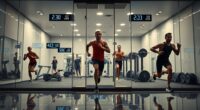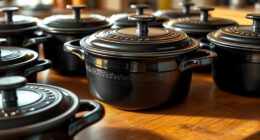Running economy determines how efficiently you use energy while running, affecting your speed and endurance. Improving it involves optimizing your breathing, footwear, and running form, which reduces fatigue and injury risk. Incorporating plyometric drills, stride adjustments, strength training, and technique-focused exercises can boost your efficiency. Mastering these drills helps you run longer and faster with less effort. Keep exploring for practical tips that will elevate your running performance even further.
Key Takeaways
- Running economy measures energy efficiency during running, affecting speed, endurance, and fatigue levels.
- Improving biomechanics, including stride length and cadence, reduces energy wastage and enhances running efficiency.
- Plyometric drills build muscular power and ankle stability, leading to more economical push-off and stride.
- Strength training enhances muscle endurance and joint stability, supporting sustained efficient running.
- Form drills focus on proper technique and breathing control, minimizing energy loss and injury risk.
Understanding Running Economy and Its Importance

Understanding running economy is essential because it directly influences how efficiently you use energy during a run. When you improve your running economy, you’ll run longer and faster with less effort. Key factors include breathing control, which helps you maintain a steady oxygen intake and reduces fatigue, and footwear selection, which impacts your stride and comfort. Proper shoes provide the right support and cushioning, minimizing energy loss and preventing injuries. By focusing on these areas, you optimize your biomechanics and conserve energy. Incorporating digital platforms for training insights and feedback can further support your progress. Remember, small adjustments in breathing techniques and choosing the right shoes can considerably enhance your efficiency. Developing a keen awareness of how these elements work together allows you to run smarter, not just harder. Incorporating yoga’s emphasis on breath awareness and mindfulness can further enhance your breathing control and overall running performance. Additionally, understanding running mechanics can help you identify and correct inefficiencies in your gait, leading to improved economy. Furthermore, the integration of neural network algorithms in training apps can provide personalized recommendations to optimize your running technique.
Plyometric Drills for Power and Efficiency
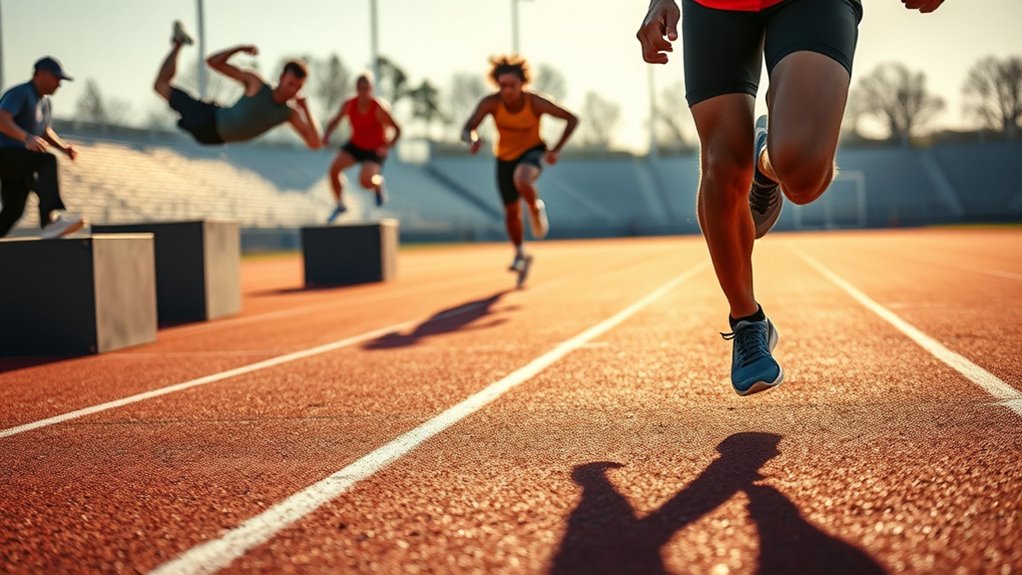
Plyometric drills are a powerful way to boost your running power and efficiency by enhancing muscle explosiveness and stride mechanics. Incorporating ankle plyometrics and explosive jumps can markedly improve your performance. To maximize benefits, focus on:
- Performing ankle plyometrics to strengthen calf muscles and improve ankle stability, aiding in more efficient push-off.
- Executing explosive jumps, such as box jumps or tuck jumps, to develop fast-twitch muscle fibers and increase power.
- Combining these drills with proper technique and controlled landings to minimize injury risk and promote better energy transfer.
Consistent practice helps refine your neuromuscular coordination, leading to a more economical stride and greater running efficiency. These plyometric exercises are essential for runners aiming to improve power without sacrificing form.
Stride Length and Cadence Optimization Techniques
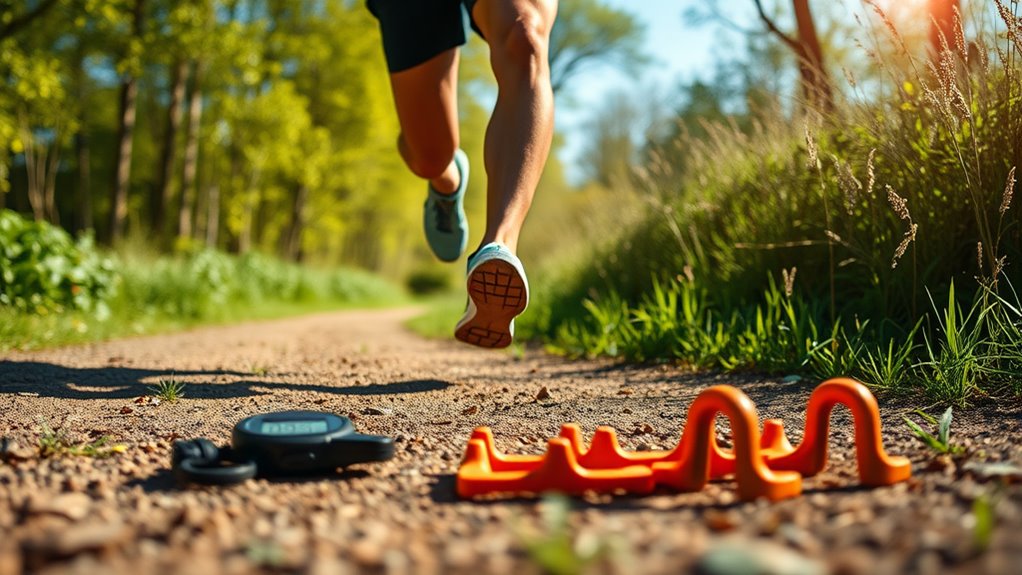
Optimizing your stride length and cadence can substantially enhance your running economy by improving how efficiently your muscles and joints work together. Focus on your stride landing; aim for a midfoot strike to reduce impact and improve energy transfer. Adjust your cadence by increasing your steps per minute, which often naturally shortens your stride and minimizes overstriding. A higher cadence helps you land more underneath your body, decreasing braking forces and wasted energy. Use drills like metronome running or cadence apps to find your ideal step rate. Consistently practicing cadence adjustment and mindful stride landing will help you run more efficiently, conserve energy, and reduce injury risk. Incorporating gait analysis can provide personalized insights to refine your running form and further improve your efficiency. Remember, small tweaks can lead to significant improvements over time. Additionally, focusing on running drills that promote proper form can accelerate your progress and help you maintain optimal biomechanics. Incorporating glycolic acid into your skincare routine can also support healthy skin, especially when managing irritation or roughness caused by increased activity or sweat.
Strength Training to Support Running Economy
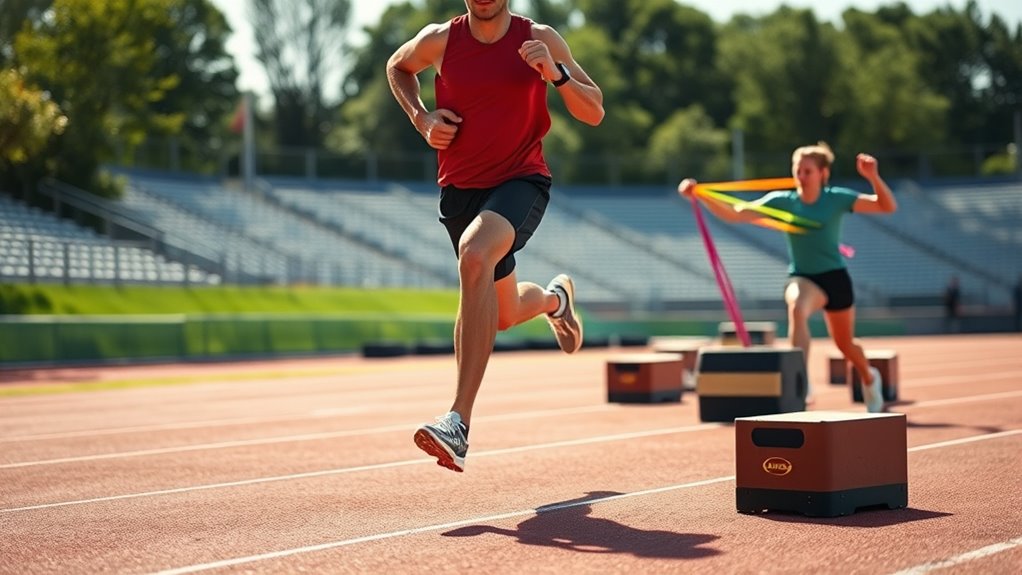
Strength training plays a crucial role in enhancing your running economy by building muscular strength and endurance that support efficient movement. Incorporating exercises like weighted squats helps strengthen your legs, improving power and stability during runs. Resistance bands are excellent for activating key muscles and increasing flexibility without adding bulk. To optimize your training, focus on:
- Performing weighted squats to boost leg strength and explosive power.
- Using resistance bands to target hip stabilizers and improve joint stability.
- Incorporating a variety of resistance exercises to enhance muscular endurance and prevent imbalances.
- Paying attention to proper projector calibration ensures accurate color reproduction, which can also translate into better visual feedback during training or analysis sessions.
Furthermore, selecting the right dog names can motivate and inspire you during your training sessions, adding a personal touch to your routine. Additionally, understanding running celebrations worldwide can inspire diverse training approaches and cultural appreciation that enrich your running experience.
These methods help you run more efficiently by reducing fatigue and improving form. Consistent strength training complements your running drills, making your movements more economical and sustainable over long distances.
Incorporating Form Drills for Better Technique
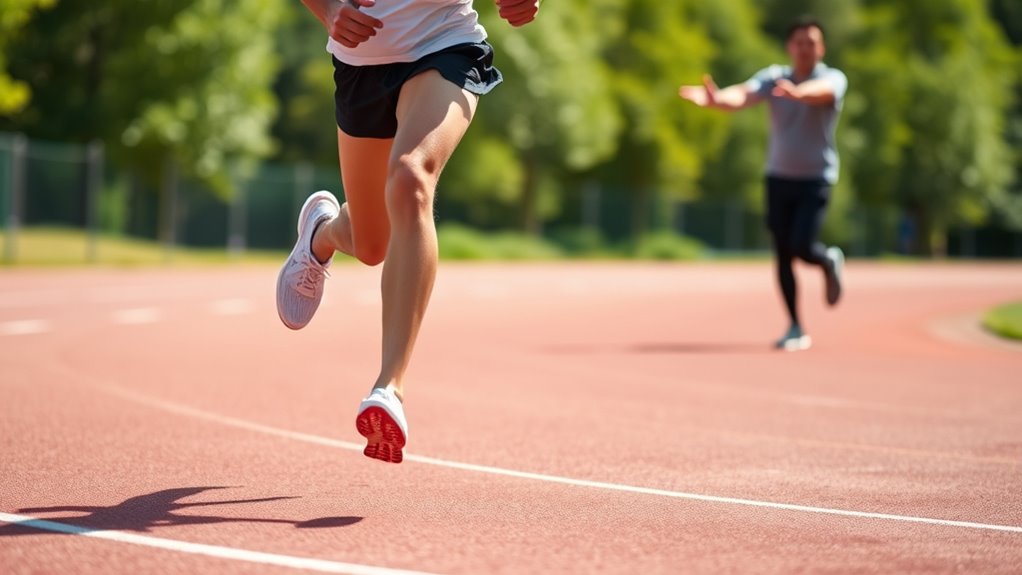
To improve your running technique, incorporating form drills is essential because they help you develop proper movement patterns and increase awareness of your body’s mechanics. Focus on breathing techniques to guarantee a steady, efficient airflow that sustains your stamina. Proper breathing reduces tension and conserves energy. Additionally, work on foot strike patterns to promote a more efficient gait. Aim for a midfoot strike, which minimizes impact and encourages better alignment. Drills like high knees, butt kicks, and skipping can reinforce these habits. Pay attention to how your feet land and how your breathing syncs with your stride. Over time, these drills improve muscle memory, reduce injury risk, and enhance overall running economy, making your running feel smoother and more effortless.
Frequently Asked Questions
How Long Does It Take to See Improvements in Running Economy?
You can usually see improvements in running economy within 4 to 6 weeks of consistent training. As you focus on drills and proper technique, your training adaptations boost biomechanical efficiency, making running feel easier. Regularly incorporating strength and form exercises helps your body adapt faster. Stay patient and committed, and you’ll notice your running becomes more efficient, with less effort for the same pace, over just a few weeks.
Can Running Economy Be Significantly Improved at Any Age?
While some believe age limits progress, you can still markedly improve your running economy at any age. Age-related adaptation slows over time, but consistent training breaks through plateaus, boosting efficiency. Don’t let a training plateau discourage you; targeted drills and proper technique can yield improvements, proving that your ability to enhance running economy endures, regardless of age. Keep pushing forward—your potential remains, no matter your age.
Are There Specific Drills for Different Running Distances?
Yes, there are specific drills for different running distances. For sprints, you might focus on plyometric drills to boost power and explosiveness. For middle-distance runs, interval training helps improve speed and endurance. Long-distance runners can benefit from longer intervals and steady-state runs. Tailoring your drills to your target race distance guarantees you’re training efficiently, enhancing your running economy and overall performance.
How Does Nutrition Impact Running Economy?
Imagine revealing hidden energy that boosts your running economy—nutrition holds that secret. Proper nutritional timing guarantees your muscles are fueled just right, while hydration strategies prevent fatigue and dehydration. When you optimize these elements, you’ll notice improved efficiency and endurance. Every sip and bite becomes a strategic move, giving you the edge you need to perform at your best. Don’t underestimate the power of good nutrition in transforming your run.
What Role Does Mental Focus Play in Running Efficiency?
Mental focus considerably impacts your running efficiency. By practicing mindfulness training, you stay present and reduce distractions, helping you conserve energy. Visualization techniques allow you to mentally rehearse proper form and pacing, boosting confidence and focus during runs. When you stay mentally engaged, you can maintain better posture, breathing, and stride, all of which improve your overall running economy. Staying focused helps you run smoother, faster, and more efficiently.
Conclusion
By focusing on improving your running economy, you’ll run more efficiently, like a well-oiled machine. Incorporate plyometric drills, optimize your stride, and strengthen your muscles to boost your performance. Remember, refining your form is like tuning a guitar—every adjustment makes your running smoother and more powerful. Keep consistent with these drills, and you’ll notice your endurance and speed grow, helping you reach your running goals with less effort and more confidence.

